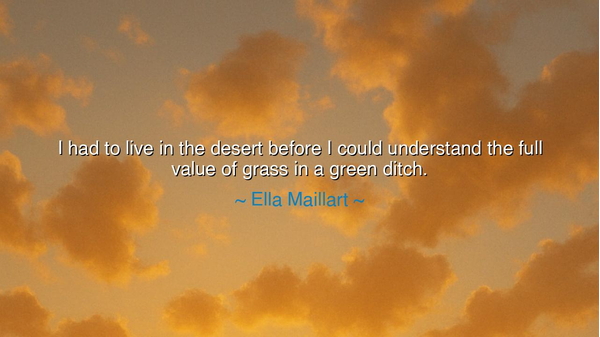
I had to live in the desert before I could understand the full
I had to live in the desert before I could understand the full value of grass in a green ditch.






Hearken, children of reflection, to the words of Ella Maillart, who spoke from the depths of experience and wandering: "I had to live in the desert before I could understand the full value of grass in a green ditch." In these words lies a meditation on perspective, deprivation, and appreciation. Maillart teaches that true understanding often comes not from abundance, but from encountering scarcity, from walking through the barren and desolate places that illuminate the treasures of the ordinary.
The first revelation is that contrast shapes perception. The desert, with its harsh winds, relentless sun, and barren expanse, teaches lessons of endurance, humility, and attentiveness. Only after experiencing this extreme can one fully recognize the softness, vitality, and simple beauty of grass in a ditch—a detail often overlooked by those who have never known lack. Value is illuminated by absence; beauty is appreciated through comparison and suffering.
History offers examples of this insight. Consider Saint Anthony of Egypt, who withdrew to the deserts of the Nile to live in solitude and austerity. Through this trial, he came to value the simplest forms of life, the whispers of wind, the shade of a single tree, and the presence of water. From desolation, the ordinary revealed itself as miraculous, precious, and full of life. The desert became his teacher, and in it, he learned the worth of what others might dismiss as mundane.
Maillart’s reflection also speaks to human journeys of exploration, both literal and metaphorical. Travelers, exiles, and seekers often endure hardship to return with eyes opened to treasures previously taken for granted. Consider Frederick Douglass, whose years in bondage imbued him with profound gratitude for the freedom and dignity that free men often overlook. The deserts of oppression sharpened his vision, revealing the true value of liberties that others may walk past unseeing.
The grass in a green ditch symbolizes the richness of the everyday world, the quiet, abundant blessings that surround us. It teaches that fulfillment is often hidden in simplicity, that gratitude arises when we have confronted the extremes of want, danger, or limitation. Only through the trials of the harsh and unforgiving landscape does the heart learn to cherish what is humble, nearby, and often ignored.
This lesson calls for patience, humility, and attentiveness. One must embrace hardship, knowing that it shapes the capacity for wonder. Difficult journeys, trials of body or spirit, and periods of scarcity are not merely obstacles—they are mirrors that reflect the value of ordinary blessings. The desert is not punishment but a teacher, revealing what the green ditch holds.
Practically, the teaching invites the cultivation of gratitude and mindful appreciation. Attend to the small joys, the overlooked comforts, and the simple beauties of life: a patch of grass, a flowing stream, a warm hearth, or a shared meal. Recognize that their significance is amplified by understanding what it is to lack, and let your experience of hardship inform your reverence for the ordinary.
Thus, let this wisdom echo through the generations: the desert teaches endurance, humility, and insight; the grass in a green ditch embodies the blessings that await recognition. Walk through hardship, endure the barren, and return with eyes and heart awakened. In this contrast lies the deepest understanding of value, beauty, and gratitude, and the soul learns to treasure life in all its quiet richness.






AAdministratorAdministrator
Welcome, honored guests. Please leave a comment, we will respond soon